Stable Matching Assisted Resource Allocation in Fog Computing Based IoT Networks
Abstract
:1. Introduction
2. Related Works
2.1. Literature Review
2.2. Novelty of the Proposed Work
3. System Model
3.1. Energy Consumption Model
3.2. Secrecy Rate
3.3. Problem Formulation
4. Proposed Task Offloading Technique
4.1. Stable Matching Game
4.2. Fog Node Selection
4.3. Preference Profile
4.4. Task Offloading Algorithm
| Algorithm 1: Proposed Task Offloading Algorithm |
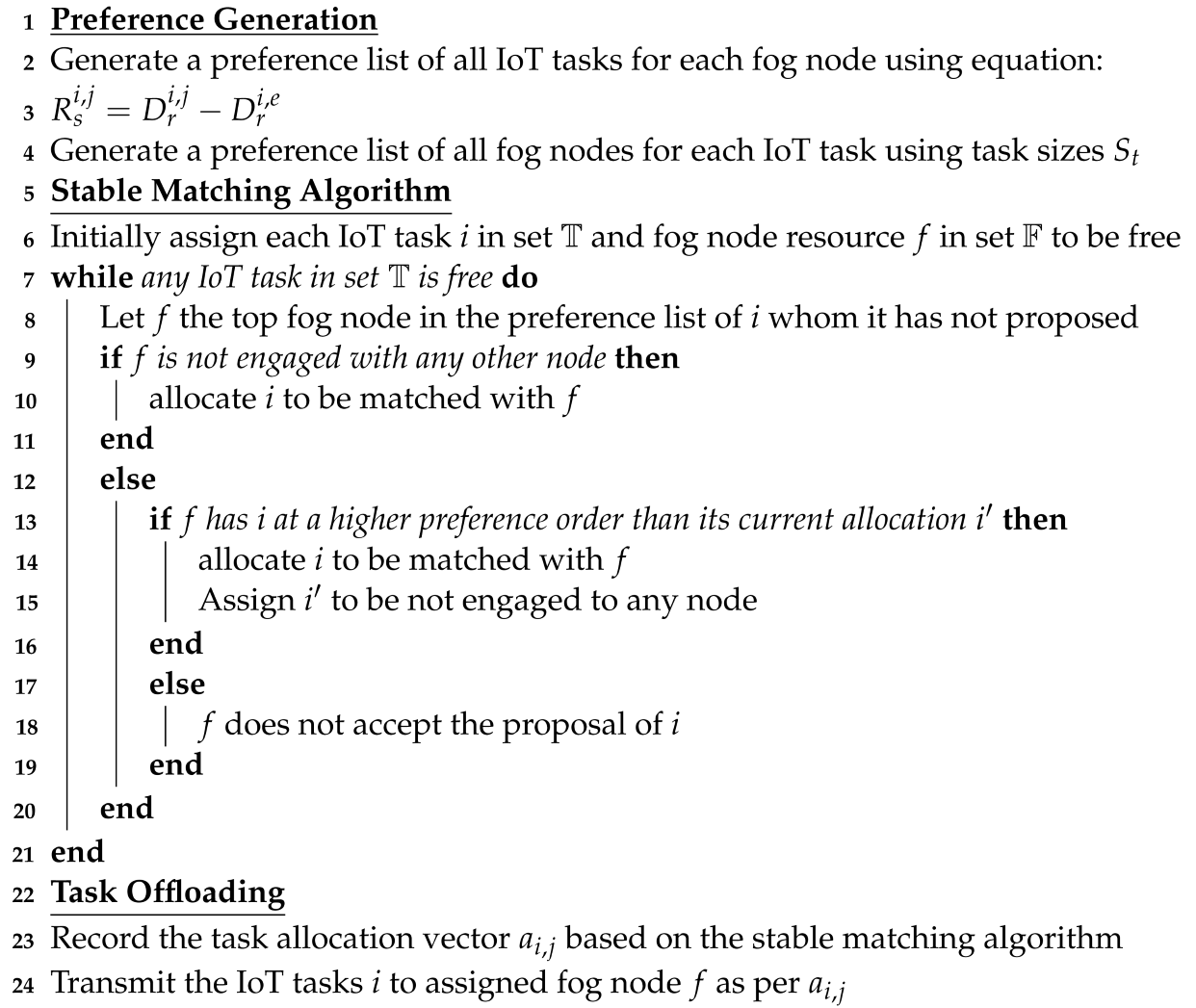 |
5. Performance Evaluation
5.1. Simulation Model
5.2. Results
- Total Delay: This is the time taken for the task to be transmitted to the fog node and computed at the fog node, and any queuing delay faced by the task.
- Secrecy Rate: This is the difference between the data rates of the IoT-fog node-link and IoT-eavesdropper link.
- Percentage of Security Outages: This is the percentage of tasks for which the data rate of the IoT-eavesdropper link is higher than the IoT-fog node link. As a result, the eavesdropper can capture the packet and decode it.
- Resource Utilization: This is the computational capacity of the fog node that is used for task offloading. Some computational capacity may remain unmatched as a result of the matching process.
- Total Energy Consumption: This is the energy consumed for the transmission and computation of the task.
5.3. Discussion
6. Future Opportunities
6.1. Transmit Power Optimization
6.2. Physical Layer Security with Jamming
6.3. Channel Estimation
7. Conclusions
Author Contributions
Funding
Data Availability Statement
Conflicts of Interest
References
- Zhao, D.; Liu, C.; Xu, G.; Ding, Z.; Peng, H.; Yu, J.; Han, J. A security enhancement model based on switching edge strategy in interdependent heterogeneous cyber-physical systems. China Commun. 2022, 19, 158–173. [Google Scholar] [CrossRef]
- Ali, R.; Zikria, Y.B.; Garg, S.; Bashir, A.K.; Obaidat, M.S.; Kim, H.S. A Federated Reinforcement Learning Framework for Incumbent Technologies in Beyond 5G Networks. IEEE Netw. 2021, 35, 152–159. [Google Scholar] [CrossRef]
- Islam, M.Z.; Ali, R.; Haider, A.; Kim, H.S. QoS Provisioning: Key Drivers and Enablers Toward the Tactile Internet in Beyond 5G Era. IEEE Access 2022, 10, 85720–85754. [Google Scholar] [CrossRef]
- Javed, M.A.; Nguyen, T.N.; Mirza, J.; Ahmed, J.; Ali, B. Reliable Communications for Cybertwin driven 6G IoVs using Intelligent Reflecting Surfaces. IEEE Trans. Ind. Inform. 2022, 18, 7454–7462. [Google Scholar] [CrossRef]
- Jouhari, M.; Saeed, N.; Alouini, M.S.; Amhoud, E.M. A Survey on Scalable LoRaWAN for Massive IoT: Recent Advances, Potentials, and Challenges. IEEE Commun. Surv. Tutor. 2023, 25, 1841–1876. [Google Scholar] [CrossRef]
- Fizza, K.; Banerjee, A.; Jayaraman, P.P.; Auluck, N.; Ranjan, R.; Mitra, K.; Georgakopoulos, D. A Survey on Evaluating the Quality of Autonomic Internet of Things Applications. IEEE Commun. Surv. Tutor. 2023, 25, 567–590. [Google Scholar] [CrossRef]
- Janssen, T.; Koppert, A.; Berkvens, R.; Weyn, M. A Survey on IoT Positioning Leveraging LPWAN, GNSS, and LEO-PNT. IEEE Internet Things J. 2023, 10, 11135–11159. [Google Scholar] [CrossRef]
- Baker, S.; Xiang, W. Artificial Intelligence of Things for Smarter Healthcare: A Survey of Advancements, Challenges, and Opportunities. IEEE Commun. Surv. Tutor. 2023, 25, 1261–1293. [Google Scholar] [CrossRef]
- Zeng, F.; Tang, J.; Liu, C.; Deng, X.; Li, W. Task-Offloading Strategy Based on Performance Prediction in Vehicular Edge Computing. Mathematics 2022, 10, 1010. [Google Scholar] [CrossRef]
- AlShathri, S.I.; Chelloug, S.A.; Hassan, D.S.M. Parallel Meta-Heuristics for Solving Dynamic Offloading in Fog Computing. Mathematics 2022, 10, 1258. [Google Scholar] [CrossRef]
- Zhong, X.; Fan, C.; Zhou, S. Eavesdropping area for evaluating the security of wireless communications. China Commun. 2022, 19, 145–157. [Google Scholar] [CrossRef]
- Pirayesh, H.; Zeng, H. Jamming Attacks and Anti-Jamming Strategies in Wireless Networks: A Comprehensive Survey. IEEE Commun. Surv. Tutor. 2022, 24, 767–809. [Google Scholar] [CrossRef]
- Ahanger, T.A.; Tariq, U.; Ibrahim, A.; Ullah, I.; Bouteraa, Y.; Gebali, F. Securing IoT-Empowered Fog Computing Systems: Machine Learning Perspective. Mathematics 2022, 10, 1298. [Google Scholar] [CrossRef]
- Li, G.; Lai, C.; Lu, R.; Zheng, D. SecCDV: A Security Reference Architecture for Cybertwin-Driven 6G V2X. IEEE Trans. Veh. Technol. 2022, 71, 4535–4550. [Google Scholar] [CrossRef]
- Javed, M.A.; Zeadally, S.; Hamid, Z. Trust-based security adaptation mechanism for Vehicular Sensor Networks. Comput. Netw. 2018, 137, 27–36. [Google Scholar] [CrossRef]
- Dhelim, S.; Aung, N.; Kechadi, M.T.; Ning, H.; Chen, L.; Lakas, A. Trust2Vec: Large-Scale IoT Trust Management System Based on Signed Network Embeddings. IEEE Internet Things J. 2023, 10, 553–562. [Google Scholar] [CrossRef]
- Bahutair, M.; Bouguettaya, A.; Neiat, A.G. Multi-Use Trust in Crowdsourced IoT Services. IEEE Trans. Serv. Comput. 2023, 16, 1268–1281. [Google Scholar] [CrossRef]
- Liu, Y.; Zhang, C.; Yan, Y.; Zhou, X.; Tian, Z.; Zhang, J. A Semi-Centralized Trust Management Model Based on Blockchain for Data Exchange in IoT System. IEEE Trans. Serv. Comput. 2023, 16, 858–871. [Google Scholar] [CrossRef]
- Soleymani, S.A.; Goudarzi, S.; Anisi, M.H.; Movahedi, Z.; Jindal, A.; Kama, N. PACMAN: Privacy-Preserving Authentication Scheme for Managing Cybertwin-Based 6G Networking. IEEE Trans. Ind. Inform. 2022, 18, 4902–4911. [Google Scholar] [CrossRef]
- Javed, M.A.; Hamida, E.B.; Al-Fuqaha, A.; Bhargava, B. Adaptive Security for Intelligent Transport System Applications. IEEE Intell. Transp. Syst. Mag. 2018, 10, 110–120. [Google Scholar] [CrossRef]
- Bachiega, J.; Costa, B.; Carvalho, L.R.; Rosa, M.J.F.; Araujo, A. Computational Resource Allocation in Fog Computing: A Comprehensive Survey. ACM Comput. Surv. 2023, 55, 1–31. [Google Scholar] [CrossRef]
- Tian, S.; Deng, X.; Chen, P.; Pei, T.; Oh, S.; Xue, W. A dynamic task offloading algorithm based on greedy matching in vehicle network. Ad Hoc Netw. 2021, 123, 102639. [Google Scholar] [CrossRef]
- Patel, Y.S.; Reddy, M.; Misra, R. Energy and cost trade-off for computational tasks offloading in mobile multi-tenant clouds. Clust. Comput. 2021, 24, 1793–1824. [Google Scholar] [CrossRef]
- Malik, U.M.; Javed, M.A.; Frnda, J.; Rozhon, J.; Khan, W.U. Efficient Matching-Based Parallel Task Offloading in IoT Networks. Sensors 2022, 22, 6906. [Google Scholar] [CrossRef] [PubMed]
- Swain, C.; Sahoo, M.N.; Satpathy, A.; Muhammad, K.; Bakshi, S.; Rodrigues, J.J.P.C.; de Albuquerque, V.H.C. METO: Matching-Theory-Based Efficient Task Offloading in IoT-Fog Interconnection Networks. IEEE Internet Things J. 2021, 8, 12705–12715. [Google Scholar] [CrossRef]
- Alvi, A.N.; Javed, M.A.; Hasanat, M.H.A.; Khan, M.B.; Saudagar, A.K.J.; Alkhathami, M.; Farooq, U. Intelligent Task Offloading in Fog Computing Based Vehicular Networks. Appl. Sci. 2022, 12, 4521. [Google Scholar] [CrossRef]
- Liu, Z.; Yang, X.; Yang, Y.; Wang, K.; Mao, G. DATS: Dispersive Stable Task Scheduling in Heterogeneous Fog Networks. IEEE Internet Things J. 2019, 6, 3423–3436. [Google Scholar] [CrossRef]
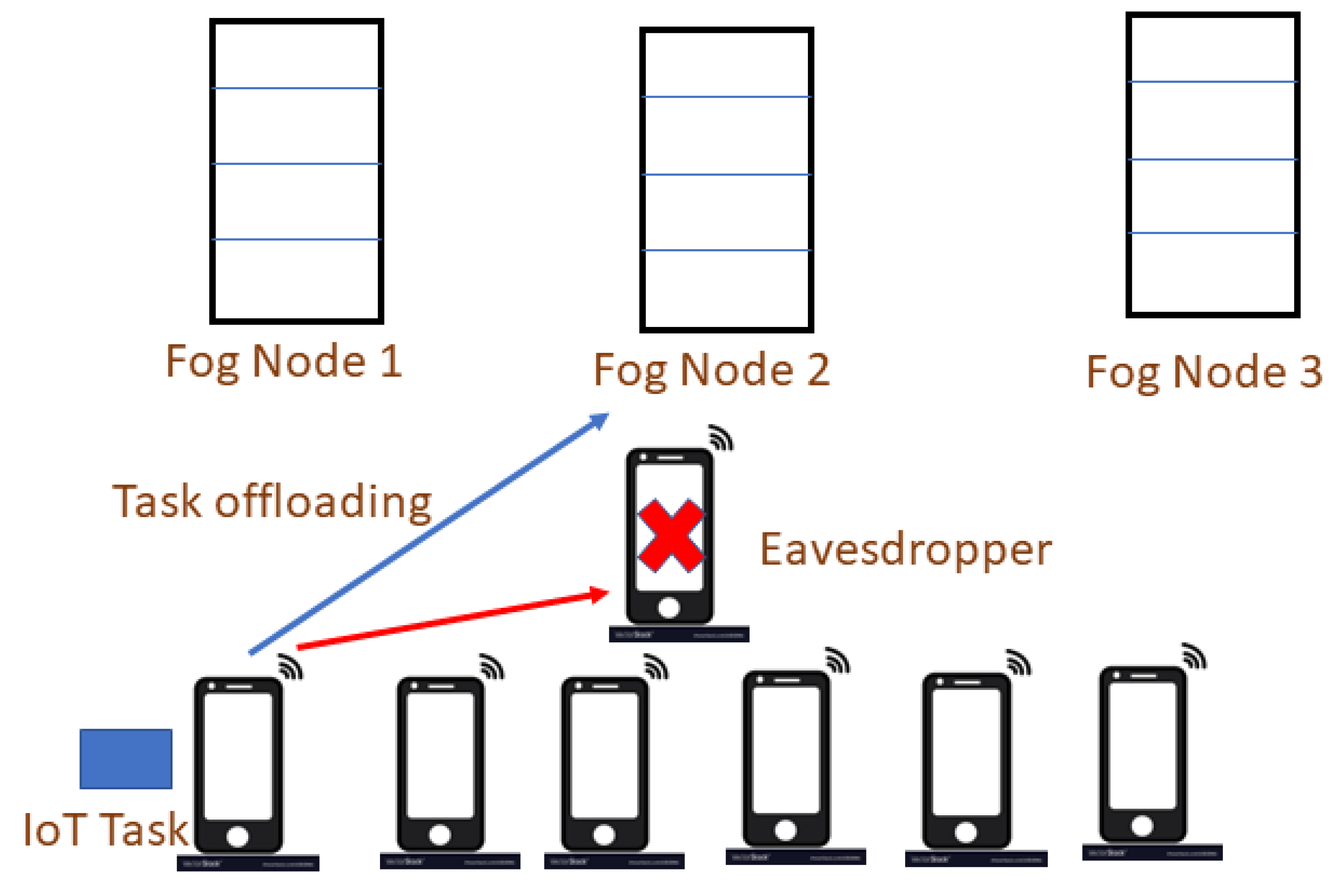

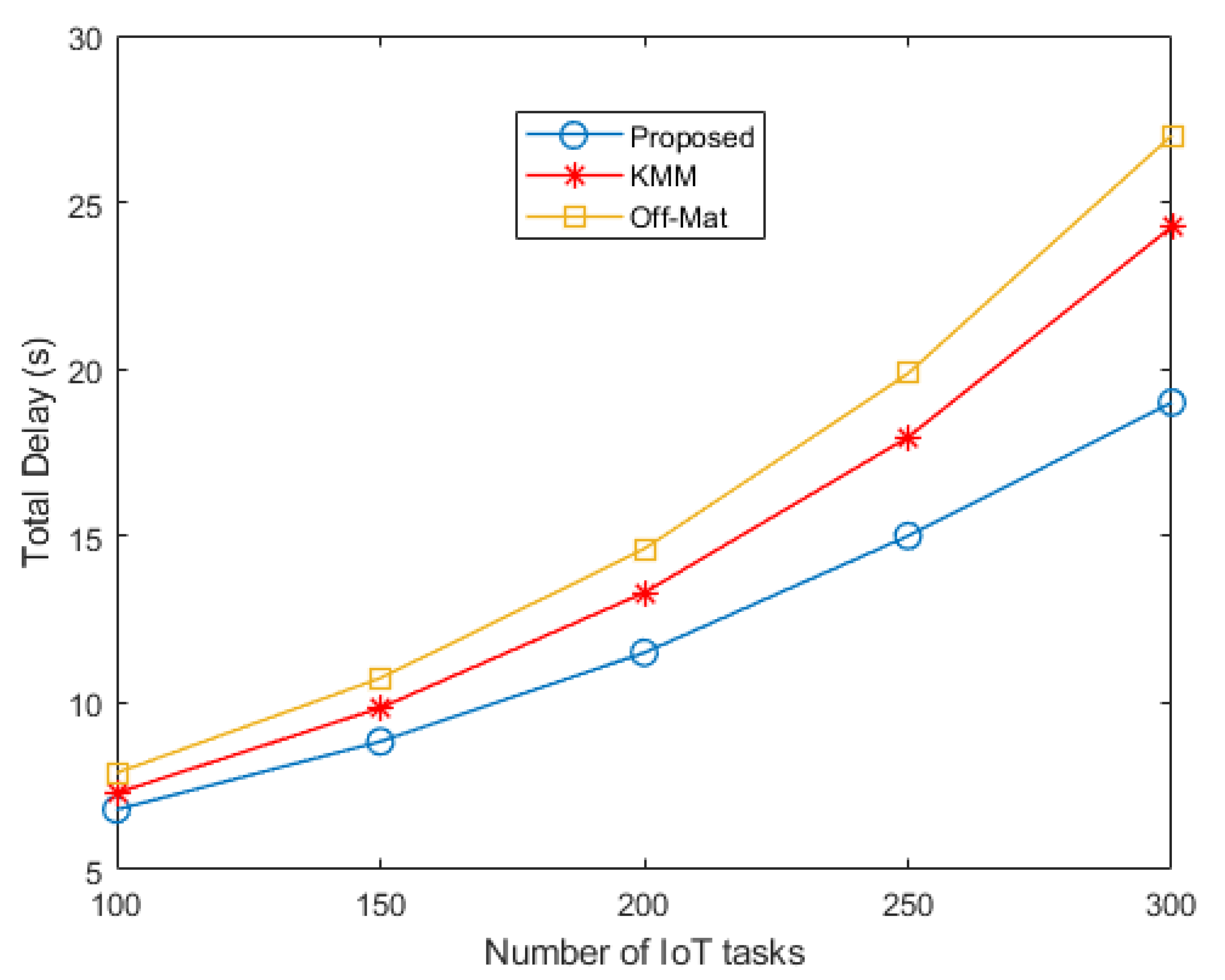
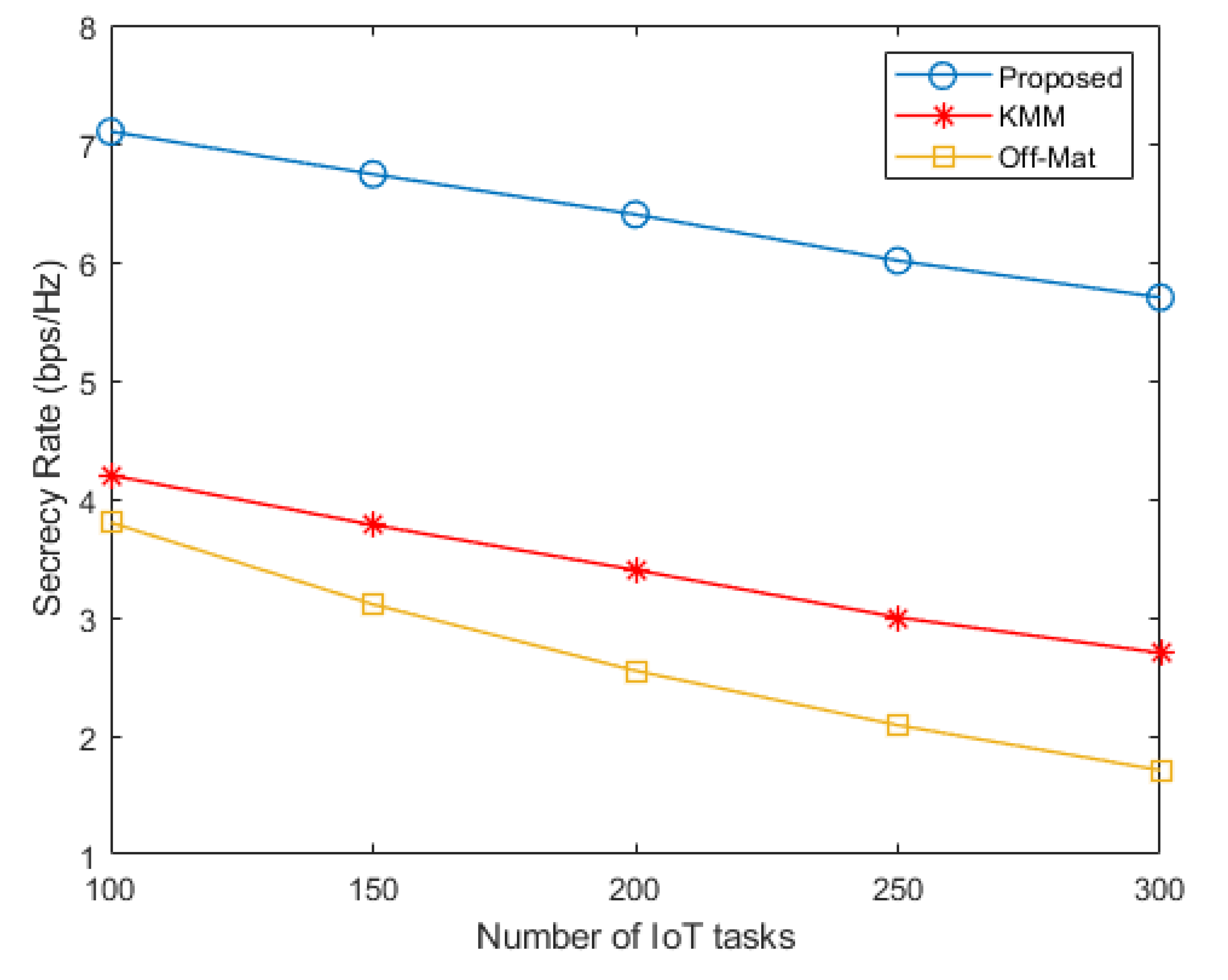


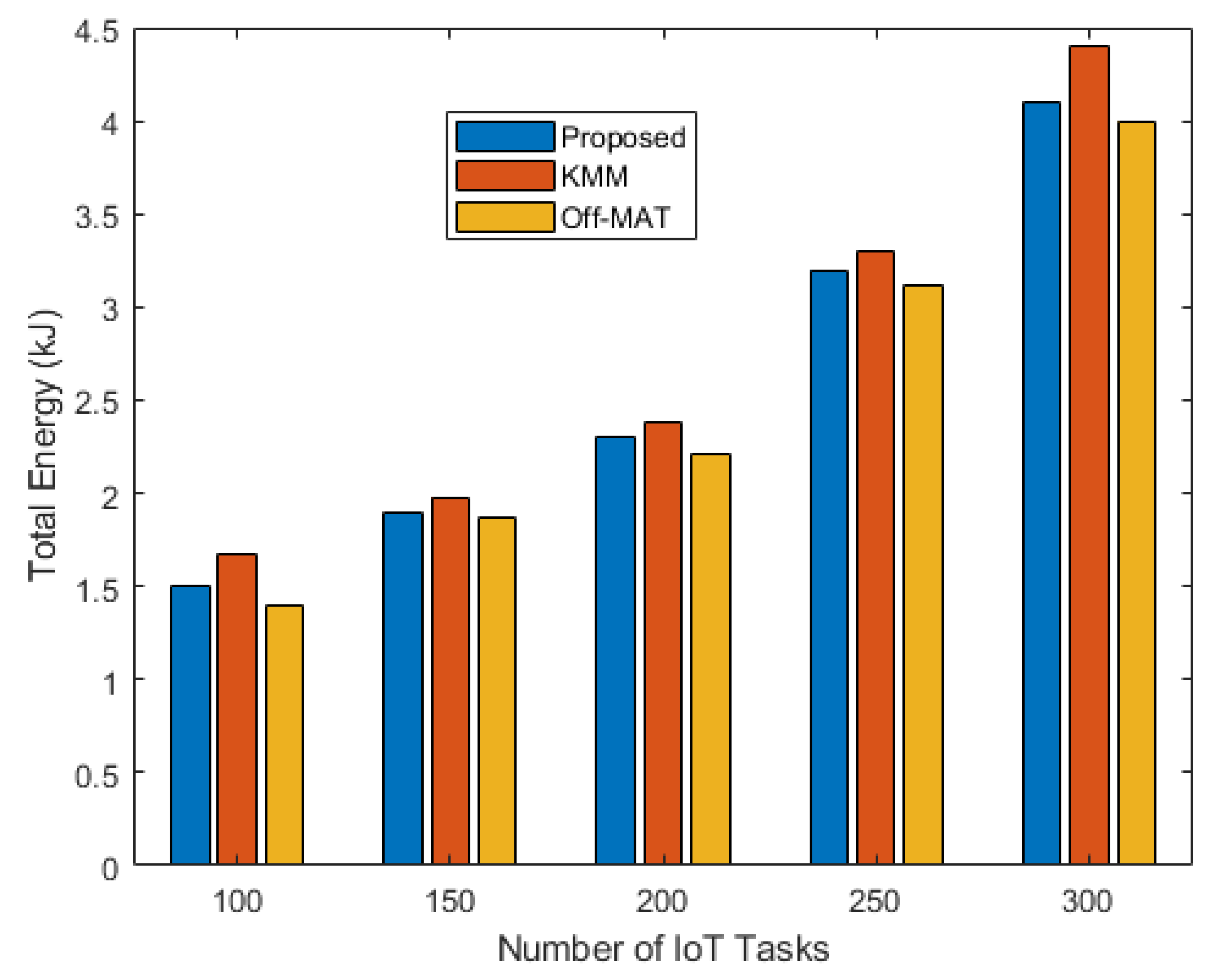
| Network | Main Idea | Technique Used | Results |
|---|---|---|---|
| Vehicular [22] | Use of mobility dynamic connectivity | Maximum bi-partite matching Kuhn–Munkras algorithm | Task response time |
| Mobile [23] | Minimize energy consumption Minimize monetary cost | Distributed matching Preference based on task size and revenue | Energy consumption Monetary cost |
| IoT [24] | Minimize task latency | Parallel offloading many to one matching | Task latency Resource utilization |
| IoT [25] | Minimize energy consumption Reduce task outages | Task deadline One to many matching Ranking based on multiple criteria | Energy consumption Task outages |
| Vehicular [26] | Quick task offloading Task priorities | Knapsack algorithm Priority based execution | Task delay |
| IoT [27] | Task latency reduction | Best preference selection Matching algorithm | Task latency |
| Symbol | Meaning |
|---|---|
| Size of task | |
| Set of tasks | |
| Set of fog node resources | |
| Computational capacity of fog nodes in bits/s | |
| Total task delay | |
| Transmission delay | |
| Computational delay | |
| Queuing delay | |
| Data rate | |
| Transmit power of IoT node i | |
| Channel gain for IoT node i, Fog node j link | |
| B | Channel bandwidth |
| Noise power | |
| Computational speed of fog node in cycles/s | |
| Computational speed of fog node in bits/cycle | |
| N | Number of tasks computed in parallel by fog node |
| Number of the given task in the queue at the fog node | |
| Energy consumed by the IoT node i | |
| Energy consumed by the Fog node f | |
| Secrecy rate for IoT node i and fog node j link in presence of eavesdropper | |
| Q | Quota of fog node |
| Task offloading vector |
| Node | Preference Profile Factors | Reason |
|---|---|---|
| IoT | Data rate between IoT node and Fog node Secrecy rate of IoT and eavesdropper link | Reduce transmission delay Increase security of transmission |
| Fog | Size of Task | Reduce fog node energy |
| Parameter | Value |
|---|---|
| Number of Fog nodes | 5 |
| Number of IoT nodes | 100–300 |
| Task generated per IoT node | 1 |
| Task Size | 3–5 MB |
| Computational speed of fog node | 6 GHz |
| Link Bandwidth | 10 MHz |
| Transmit power of IoT nodes | 0.5 W |
| Computational power of fog nodes | 0.3–0.5 W |
| Quota of fog nodes | 20–50 |
Disclaimer/Publisher’s Note: The statements, opinions and data contained in all publications are solely those of the individual author(s) and contributor(s) and not of MDPI and/or the editor(s). MDPI and/or the editor(s) disclaim responsibility for any injury to people or property resulting from any ideas, methods, instructions or products referred to in the content. |
© 2023 by the authors. Licensee MDPI, Basel, Switzerland. This article is an open access article distributed under the terms and conditions of the Creative Commons Attribution (CC BY) license (https://creativecommons.org/licenses/by/4.0/).
Share and Cite
Alfakeeh, A.S.; Javed, M.A. Stable Matching Assisted Resource Allocation in Fog Computing Based IoT Networks. Mathematics 2023, 11, 3798. https://doi.org/10.3390/math11173798
Alfakeeh AS, Javed MA. Stable Matching Assisted Resource Allocation in Fog Computing Based IoT Networks. Mathematics. 2023; 11(17):3798. https://doi.org/10.3390/math11173798
Chicago/Turabian StyleAlfakeeh, Ahmed S., and Muhammad Awais Javed. 2023. "Stable Matching Assisted Resource Allocation in Fog Computing Based IoT Networks" Mathematics 11, no. 17: 3798. https://doi.org/10.3390/math11173798
APA StyleAlfakeeh, A. S., & Javed, M. A. (2023). Stable Matching Assisted Resource Allocation in Fog Computing Based IoT Networks. Mathematics, 11(17), 3798. https://doi.org/10.3390/math11173798







